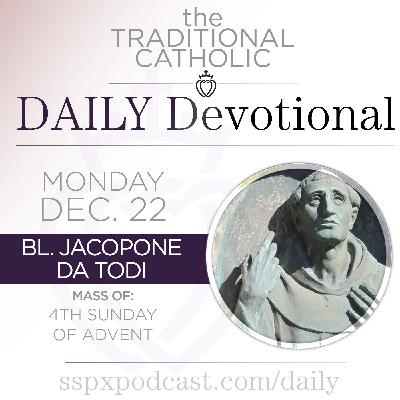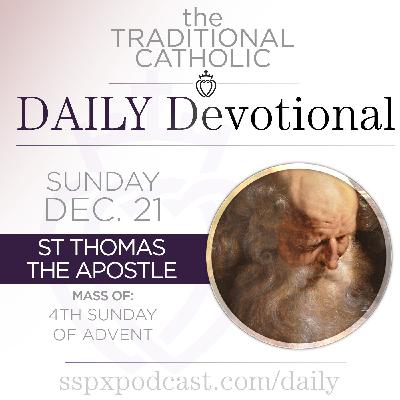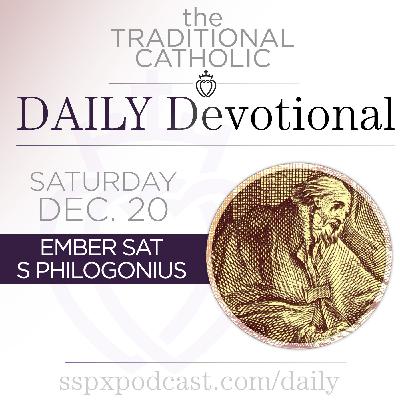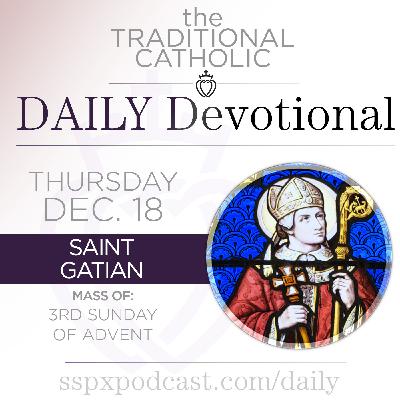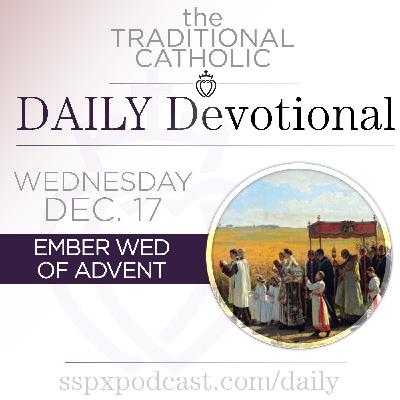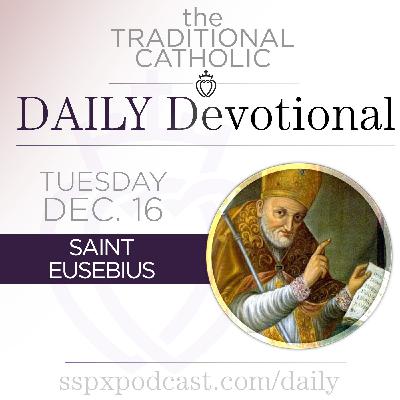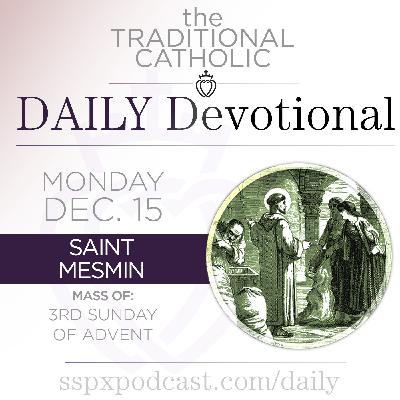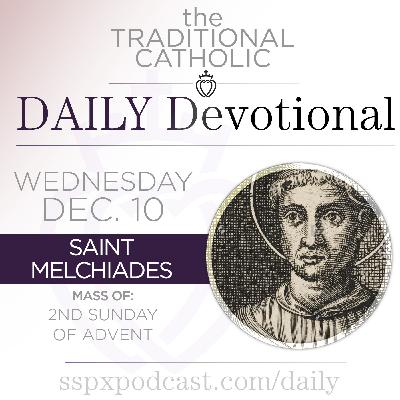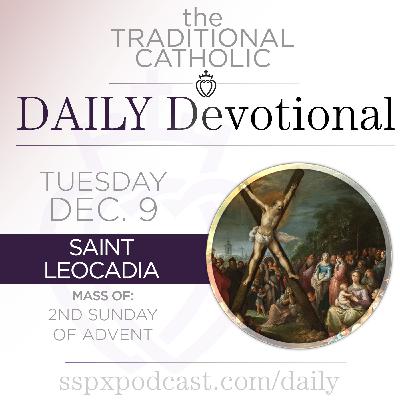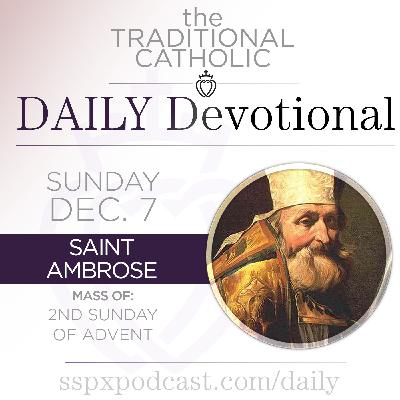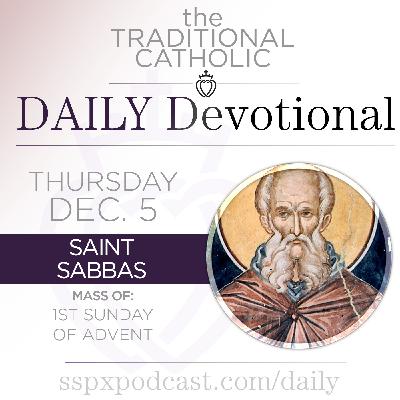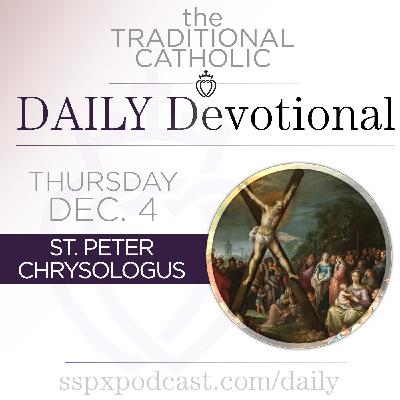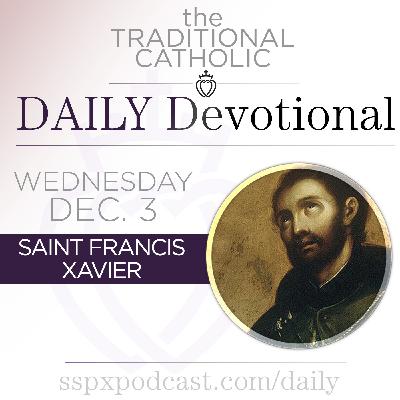Discover Traditional Catholic Daily Devotional
Traditional Catholic Daily Devotional

Traditional Catholic Daily Devotional
Author: SSPX US District, Angelus Press
Subscribed: 22Played: 2,047Subscribe
Share
© Copyright 2025 SSPX US District, Angelus Press
Description
All in 6-8 minutes: Start each day with the Collect of the Mass, asking for God's graces. Then we'll give a short consideration of today's saint or feast, and a reflection of the day from Scripture. Then we'll keep you up to date on Church news, or give a preview of one of our podcasts or sermons. Finally, we close with a thought from Archbishop Lefebvre.
272 Episodes
Reverse
It’s the Feast of Advent Feria, 2nd Class, with the color of Violet. In this episode: the meditation: “The O Antiphons: O Rex Gentium, Penance and Reconciliation”, today’s news from the Church: “Australian Ban on Social Media Access for People Under 16 Years of Age”, a preview of the Sermon: “A Man in Love”, and today’s thought from the Archbishop.
Have feedback or questions about the DD or our other shows? podcast@sspx.org
Sources Used Today:
“The O Antiphons: O Rex Gentium” – (FSSPX.news)https://fsspx.news/en/news/preparation-christmas-o-antiphons-december-22-27197
“Penance and Reconciliation” – From Advent to Epiphany
https://angeluspress.org/products/from-advent-to-epiphany
“Australian Ban on Social Media Access for People Under 16 Years of Age” (FSSPX.news)
https://fsspx.news/en/news/australia-ban-social-media-access-people-under-16-years-age-56060
“A Man in Love” (SSPX Sermons)
SSPX YouTube: Sermons PlaylistListen & Subscribe: SSPX Sermons Podcast
The Spiritual Life – Archbishop Lefebvre (Angelus Press)
https://angeluspress.org/products/spiritual-life-archbishop
Blessed Jacopone da Todi lived one of the most dramatic conversions of the Middle Ages, moving from worldly success to radical poverty through suffering and grace. He was born around 1230 in Todi, Italy, and trained as a lawyer. Intelligent, ambitious, and well connected, Jacopone enjoyed the comforts and honors of public life. He married a noblewoman and seemed set for a prosperous future. All of that changed suddenly when his wife was killed in a tragic accident during a public celebration.
While grieving her death, Jacopone discovered that she had been secretly wearing a hair shirt as an act of penance. This revelation shattered him. He realized how little he had understood her interior life and how shallow his own priorities had been. For years afterward, he lived in deep sorrow and repentance, eventually renouncing his wealth and embracing a life of radical poverty. He joined the Franciscan Order as a lay brother, choosing humility, obscurity, and penance rather than status or recognition.
Jacopone became known for his sharp wit, fearless criticism of corruption, and passionate love for...
It’s the Feast of IV Sun of Advent, 1st Class, with the color of Violet. In this episode: the meditation: “The O Antiphons: O Oriens, Final Preparation for Christmas”, today’s news from the Church: “Co-Redemptrix and Mediatrix: What the Bishops Asked For on the Eve of Vatican II”, and today’s thought from the Archbishop.
Have feedback or questions about the DD or our other shows? podcast@sspx.org
Sources Used Today:
“The O Antiphons: O Oriens” (FSSPX.news)https://fsspx.news/en/news/preparation-christmas-o-antiphons-december-21-27193
“Final Preparation for Christmas” – From Advent to Epiphany
https://angeluspress.org/products/from-advent-to-epiphany
“Co-Redemptrix and Mediatrix: What the Bishops Asked For on the Eve of Vatican II” (FSSPX.news)
https://fsspx.news/en/news/co-redemptrix-and-mediatrix-what-bishops-asked-eve-vatican-ii-55947
The Spiritual Life – Archbishop Lefebvre (Angelus Press)
https://angeluspress.org/products/spiritual-life-archbishop
Saint Thomas the Apostle is remembered most often for a single moment of doubt, yet that moment became the doorway to one of the strongest confessions of faith in the Gospels. Thomas appears several times in Saint John’s Gospel, always asking the question others are thinking but are afraid to voice. When Jesus proposes returning to Judea despite danger, Thomas is the one who says plainly, “Let us go also, that we may die with him.” His faith was not timid. It was honest, direct, and willing to follow even when the road looked dark.
After the Resurrection, Thomas struggled to accept what the others proclaimed. He wanted more than reports. He wanted encounter. When Christ appeared again and invited Thomas to touch his wounds, the apostle responded not with embarrassment but with awe. “My Lord and my God,” he said, offering the clearest confession of Christ’s divinity recorded in the New Testament. That cry reveals who Thomas truly was. Once convinced, he was utterly convinced. His doubt did not weaken his faith. It purified it.
Ancient tradition holds that Thomas carried the Gospel farther than any other apostle. He traveled east, preaching in Persia and eventually reaching the Malabar Coast of India. There he founded Christian communities that survive to this day as the Saint Thomas Christians. He baptized, ordained clergy, and built churches among peoples entirely new to the faith. His mission ended in martyrdom near present day Chennai, where he was killed for refusing to abandon his preaching. His relics became objects of
It’s the Ember Saturday in Advent, 2nd Class, with the color of Violet. In this episode: the meditation: “The O Antiphons: O Clavis David, Jesus and His Percursor”, today’s news from the Church: “Proposed Canadian Law Could Condemn the Bible as “Hate Speech””, and today’s thought from the Archbishop.
Have feedback or questions about the DD or our other shows? podcast@sspx.org
Sources Used Today:
“The O Antiphons: O Clavis David” (FSSPX.news)https://fsspx.news/en/news/preparation-christmas-o-antiphons-december-20-27187
“Magnificat” – From Advent to Epiphany
https://angeluspress.org/products/from-advent-to-epiphany
“Proposed Canadian Law Could Condemn the Bible as “Hate Speech”” (FSSPX.news)
https://fsspx.news/en/news/proposed-canadian-law-could-condemn-bible-hate-speech-55884
The Spiritual Life – Archbishop Lefebvre (Angelus Press)
https://angeluspress.org/products/spiritual-life-archbishop
Saint Philogonius of Antioch is remembered as a bishop who rose from the world of law into the service of the Church at a moment of grave danger. He lived in the early fourth century, during the height of the Arian crisis, when confusion about the identity of Christ threatened to fracture Christian unity. Philogonius was not formed in monasteries or schools of theology. He was a married man, a lawyer by profession, known in Antioch for his integrity, clarity of thought, and fairness in judgment. When his wife died, he embraced a life of continence and deeper prayer, and the Christian community, recognizing his wisdom, chose him as their bishop around the year 318.
His episcopate coincided with one of the most aggressive phases of Arian influence in the East. Powerful bishops and imperial officials promoted the teaching that Christ was not truly God, but a created being. Philogonius resisted firmly. Though not a prolific writer, his preaching was direct and uncompromising. He insisted on the full divinity of Christ and the truth handed down from the apostles, even as political pressure mounted against him. Saint John Chrysostom, who later preached a homily in his honor, praised Philogonius for defending the faith without bitterness, standing immovable while others wavered.
Philogonius suffered exile and harassment for his refusal to accept compromise. Ancient sources suggest he was driven from Antioch and endured great hardship, possibly imprisonment, though details are sparse. What endured was his reputation for calm endurance and pastoral charity. He governed not as an ideologue, but as a...
It’s the Feast of Ember Friday in Advent, 2nd Class, with the color of Violet. In this episode: the meditation: “The O Antiphons: O Radix Jesse,” and the meditation “Jesus and His Percursor”, today’s news from the Church: “The Vatican Enters a New Administrative Era”, a preview of this week’s episode of The SSPX Podcast: “The Great Joy of the Apostolate in Asia”, and today’s thought from the Archbishop.
Have feedback or questions about the DD or our other shows? podcast@sspx.org
Sources Used Today:
“The O Antiphons: O Radix JesseJesus and His Percursor” – From Advent to Epiphanyhttps://angeluspress.org/products/from-advent-to-epiphany
“The Vatican Enters a New Administrative Era” (FSSPX.news)
https://fsspx.news/en/news/vatican-enters-new-administrative-era-56061
“The Great Joy of the Apostolate in Asia” (SSPX Podcast)
View on YouTubeListen & Subscribe on SSPXpodcast.com
The Spiritual Life – Archbishop Lefebvre (Angelus Press)
https://angeluspress.org/products/spiritual-life-archbishop
St. Nemesion lived during one of the fiercest persecutions of the early Church, in the middle of the third century, when the Roman Empire demanded public loyalty through sacrifice to the pagan gods. He was a Christian layman in Egypt, likely living in Alexandria, a city known for both its learning and its volatility. In that tense atmosphere, Christians were often betrayed by neighbors, arrested on false charges, or forced to prove their loyalty to the emperor.
Nemesion’s ordeal began with an accusation that had nothing to do with religion. He was charged with being a robber and brought before the Roman governor. Calm and honest, Nemesion defended himself and proved the charge false. But instead of being released, he was denounced by another man as a Christian. That accusation sealed his fate. The governor, irritated by Nemesion’s persistence and faith, ordered him interrogated again, this time about his beliefs.
When Nemesion openly confessed that he was a Christian and would not sacrifice to idols, the tone of the trial changed. He was scourged brutally, then thrown into prison alongside criminals. Even there, he continued to confess Christ without fear. Eventually, he was condemned to death by fire, a punishment meant to terrify others into compliance. As he was led to execution, he joined his voice to the prayers of other martyrs, offering his life to God with peace and resolve.
p...
It’s the Feast of Advent Feria, 2nd Class, with the color of Violet. In this episode: the meditation: “Jesus, Eternal Wisdom”, “The O Antiphons: O Adonai” , today’s news from the Church: Bishop Eleganti: Vatican II or “The Promised Springtime That Never Happened””, a preview of the Sermon: “Anxiety and the Path to Peace”, and today’s thought from the Archbishop.
Have feedback or questions about the DD or our other shows? podcast@sspx.org
Sources Used Today:
“Jesus, Eternal Wisdom” – From Advent to Epiphanyhttps://angeluspress.org/products/from-advent-to-epiphany
“The O Antiphons: O Adonai (FSSPX.news)
https://fsspx.news/en/news/preparation-christmas-o-antiphons-december-18-27180
Bishop Eleganti: Vatican II or “The Promised Springtime That Never Happened”” (FSSPX.news)https://fsspx.news/en/news/bishop-eleganti-vatican-ii-or-promised-springtime-never-happened-56019
“Anxiety and the Path to Peace” (SSPX Sermons)
SSPX YouTube: Sermons PlaylistListen & Subscribe: SSPX Sermons Podcast
The Spiritual Life – Archbishop Lefebvre (Angelus Press)
https://angeluspress.org/products/spiritual-life-archbishop
St. Gatian was one of those quiet pioneers of the early Church, men who planted the faith in places where Christianity was barely known. He lived in the third century and is remembered as the first bishop of Tours, in what is now central France. Tradition tells us that he was sent from Rome during a time of persecution, when being a Christian bishop meant living with constant risk and very little visible success.
When Gatian arrived in Tours, the city was overwhelmingly pagan. There were no churches, no Christian community to speak of, and no protection from hostile authorities. He preached anyway. For years, his efforts seemed almost invisible. He converted only a handful of souls, often celebrating the Mass in secret and moving quietly from place to place. Yet he remained faithful, trusting that God was at work even when the results were hidden.
After nearly fifty years of patient ministry, St. Gatian died peacefully, having laid a foundation that others would build upon.
It’s the Ember Wednesday in Advent, 2nd Class, with the color of Violet. In this episode: the meditation: “Jesus, Emmanuel”, today’s news from the Church: “Centenary of Quas Primas, the Encyclical on Christ the King”, a preview of the Sermon: “Recognizing Our Lord in Our Midst”, and today’s thought from the Archbishop.
Have feedback or questions about the DD or our other shows? podcast@sspx.org
Sources Used Today:
“Jesus, Emmanuel” – From Advent to Epiphanyhttps://angeluspress.org/products/from-advent-to-epiphany
“Centenary of Quas Primas, the Encyclical on Christ the King” (FSSPX.news)
https://fsspx.news/en/news/centenary-quas-primas-encyclical-christ-king-56012
“Recognizing Our Lord in Our Midst” (SSPX Sermons)
SSPX YouTube: Sermons PlaylistListen & Subscribe: SSPX Sermons Podcast
The Spiritual Life – Archbishop Lefebvre (Angelus Press)
https://angeluspress.org/products/spiritual-life-archbishop
The Ember Days are among the Church’s oldest and most quietly profound practices, woven into the rhythm of the year long before most modern calendars took shape. In the traditional Catholic life of prayer, the Ember Days were set aside as recurring moments of fasting, abstinence, thanksgiving, and supplication, marking the turning of the seasons and consecrating time itself to God. They were not feasts in the celebratory sense, but sacred pauses, moments when the Church collectively slowed down to pray, give thanks, and ask for grace.
There are four sets of Ember Days each year, occurring on Wednesday, Friday, and Saturday after certain key points in the liturgical calendar: after the First Sunday of Lent, after Pentecost, after the Exaltation of the Holy Cross in September, and after the Third Sunday of Advent. Together, they sanctified winter, spring, summer, and autumn. Their roots stretch back to ancient Rome, where Christians adapted earlier agricultural customs, transforming prayers for harvest and fertility into acts of Christian worship. Over time, the Ember Days became deeply penitential, combining fasting with prayer for the needs of the Church and the world.
In traditional practice, the Ember Days carried several layers of meaning. They were days of thanksgiving for the fruits of the earth, recognizing God as the giver of all sustenance. They were days of penance, reminding the faithful that creation
It’s the Feast of St. Eusebius, 3rd Class, with the color of Red. In this episode: the meditation: “Jesus, Light of Soul”, today’s news from the Church: “Priests Leading to Victory”, and today’s thought from the Archbishop.
Have feedback or questions about the DD or our other shows? podcast@sspx.org
Sources Used Today:
“Jesus, Light of Soul” – From Advent to Epiphanyhttps://angeluspress.org/products/from-advent-to-epiphany
“Priests Leading to Victory” (FSSPX.news)
https://fsspx.news/en/news/priests-leading-victory-56003
The Spiritual Life – Archbishop Lefebvre (Angelus Press)
https://angeluspress.org/products/spiritual-life-archbishop
Saint Eusebius of Vercelli was a bishop whose courage helped steady the Church during one of its most dangerous theological crises. Born in Sardinia in the early fourth century, he later settled in northern Italy and became the first known bishop of Vercelli. From the beginning, he chose an unusual path. Rather than living apart from his clergy, he formed them into a common life of prayer modeled partly on monastic discipline. This combination of episcopal authority and communal holiness became a powerful witness in a time of confusion and division.
Eusebius lived during the height of the Arian controversy, when many bishops, often under political pressure, wavered in their confession of Christ as true God. Eusebius did not. He stood firmly with Saint Athanasius and defended the full divinity of Christ, even when it brought exile and suffering. At the Council of Milan in 355, he refused to condemn Athanasius as the emperor demanded. For this refusal, Eusebius was arrested and sent into exile, first to Scythopolis in the Holy Land, then to Cappadocia, and finally to Upper Egypt. His letters from exile reveal a pastor more concerned for his flock than for his own hardship. He urged perseverance, unity, and trust in God’s truth.
After years of suffering, Eusebius was allowed to return to Italy following the death of Emperor Constantius. He resumed his work with renewed zeal, helping restore orthodoxy in regions damaged by compromise. He worked closely with Saint Hilary of Poitiers and encouraged bishops to rebuild the Church not through retaliation, but through clarity and charity. His influence shaped the faith of northern Italy for generations, and his model of clergy living a shared life of prayer would echo later in canonical communities.
He died around 371, remembered as a confessor who had endured persecution without shedding blood. His tomb in Vercelli became a place of quiet devotion, especially for priests seeking fidelity...
It’s the Feast of Advent Feria, 3rd Class, with the color of Violet. In this episode: the meditation: “Jesus, Meek and Humble of Heart”, today’s news from the Church: “Polygamy: The Vatican Has No Intention of Changing Canon Law”, a preview of the Sermon: “The Dangers of Venial Sin”, and today’s thought from the Archbishop.
Have feedback or questions about the DD or our other shows? podcast@sspx.org
Sources Used Today:
“Jesus, Meek and Humble of Heart” – From Advent to Epiphanyhttps://angeluspress.org/products/from-advent-to-epiphany
“Polygamy: The Vatican Has No Intention of Changing Canon Law” (FSSPX.news)
https://fsspx.news/en/news/polygamy-vatican-has-no-intention-changing-canon-law-55955
“The Dangers of Venial Sin” (SSPX Sermons)
SSPX YouTube: Sermons PlaylistListen & Subscribe: SSPX Sermons Podcast
The Spiritual Life – Archbishop Lefebvre (Angelus Press)
https://angeluspress.org/products/spiritual-life-archbishop
Saint Mesmin, also known as Saint Maximinus of Micy, belongs to the generation of quiet founders who shaped Christian Gaul through prayer, stability, and patient leadership. He lived in the late fifth and early sixth centuries, a time when Roman authority had collapsed and much of France was being reorganized under new rulers. Amid that uncertainty, Mesmin helped anchor Christian life along the Loire through the steady rhythm of monastic prayer.
He was a disciple of Saint Euspicius, a hermit priest living near Orléans. King Clovis, newly converted to Christianity, encountered Euspicius and granted him land on the banks of the Loire at a place called Micy. There Euspicius founded a monastery, and Mesmin soon emerged as his closest collaborator. When Euspicius died, Mesmin succeeded him as abbot, guiding the community with firmness and humility. Under his leadership, the monastery of Micy became one of the most influential spiritual centers in the region, helping to evangelize the surrounding countryside and to form clergy for service in the growing Frankish Church.
Mesmin was known for his austerity and his love of silence, but also for his practical charity. He trained monks not only in prayer and fasting, but in obedience, hospitality, and manual labor. Ancient sources emphasize his authority over the spiritual realm, recording episodes in which he confronted lingering pagan...
It’s the Feast of Gaudete Sunday, 1st Class, with the color of Violet. In this episode: the meditation: “Jesus, Source of Joy”, today’s news from the Church: “Female Diaconate: Rome Says “No, But…””, and today’s thought from the Archbishop.
Have feedback or questions about the DD or our other shows? podcast@sspx.org
Sources Used Today:
“Jesus, Source of Joy” – From Advent to Epiphanyhttps://angeluspress.org/products/from-advent-to-epiphany
“Female Diaconate: Rome Says “No, But…”” (FSSPX.news)
https://fsspx.news/en/news/female-diaconate-rome-says-no-55863
The Spiritual Life – Archbishop Lefebvre (Angelus Press)
https://angeluspress.org/products/spiritual-life-archbishop
On the Third Sunday of Advent, the Church pauses and invites us to rejoice. This is Gaudete Sunday, named from the opening words of the Mass – Gaudete in Domino, “Rejoice in the Lord always.” Even the liturgical color softens, as violet gives way to rose, reminding us that our waiting is nearly over and that Christ is close at hand.
This joy is not loud or carefree. It is quiet, steady, and rooted in faith. Saint Paul tells us to rejoice because the Lord is near, to live with modesty, and to place our anxieties in God’s hands through prayer. True joy, he teaches, flows from peace of soul – the peace that comes from a good conscience and trust in God’s providence. This is the peace that sustained the martyrs and consoled the saints in suffering. It is not the absence of trials, but confidence that God is present within them.
The prayers of the Mass echo this theme. We ask God to enlighten the darkness of our minds by His coming, because real rejoicing begins when Christ draws near to us interiorly. Alongside this call to joy, the Church places before us Saint John the Baptist. When questioned about who he was, John refused every honor. He was not the Christ, not Elias, not the prophet – only a voice preparing the way of the Lord. His humility teaches us how to prepare for Christ’s coming: by repentance, sincerity, and a complete turning away from sin.
To bear worthy fruits of penance means more than regret. It means changing direction – using our words, senses, and actions for God where once they served sin. John’s baptism prepared souls for Christ by awakening them to their need for conversion.
Gaudete Sunday reminds us that Advent is not only about waiting, but about hopeful expectation. Christ is near. Rejoice – not because life is easy, but because God is faithful, His peace is real, and His coming brings light to...
It’s the Feast of St. Lucy, 3rd Class, with the color of Red. In this episode: the meditation: “Jesus, Occasion of Falls”, today’s news from the Church: “Exclusive Interview with Bishop Bernard Fellay with Immaculata TV, Kenya”, and today’s thought from the Archbishop.
Have feedback or questions about the DD or our other shows? podcast@sspx.org
Sources Used Today:
“Jesus, Occasion of Falls” – From Advent to Epiphanyhttps://angeluspress.org/products/from-advent-to-epiphany
“Exclusive Interview with Bishop Bernard Fellay with Immaculata TV, Kenya” (FSSPX.news)
https://fsspx.news/en/news/exclusive-interview-bishop-bernard-fellay-sspx-55980
The Spiritual Life – Archbishop Lefebvre (Angelus Press)
https://angeluspress.org/products/spiritual-life-archbishop
Saint Lucy of Syracuse is one of the most luminous martyrs of the early Church, a young woman whose witness left an imprint far larger than the brief span of her life. She lived in the early fourth century in Sicily during the persecution of Christians under Emperor Diocletian. Lucy was born into a wealthy family, but from an early age she consecrated her virginity to Christ. After the death of her father, her mother sought to arrange a marriage for her. Lucy delayed the plans, praying instead for her mother’s healing from a long illness. When her mother was cured through the intercession of Saint Agatha, Lucy revealed her vow and resolved to give her inheritance to the poor.
This decision set the course for her martyrdom. The rejected suitor denounced her as a Christian, and Lucy was brought before the authorities. Threatened with defilement and punishment, she stood firm, declaring that her body belonged to God and that no violence could separate her from Christ. Ancient accounts describe her as miraculously immovable when soldiers tried to drag her away, as if rooted in place by divine power. Eventually she was killed for her faith, likely by the sword. Though the details of her death vary across early sources, what remained constant was the memory of her courage and clarity of conscience.
Lucy’s name means light, and the Church has always seen in her a reflection of spiritual brightness that no darkness could overcome. Her martyrdom came at the height of winter, when days are shortest, and this symbolism was not lost on early Christians. She was remembered as a saint who carried Christ’s light into a season of fear, coercion, and uncertainty. Her tomb in Syracuse became a place of prayer almost immediately, and devotion to her spread rapidly throughout Italy and into northern Europe.
It’s the Feast of Our Lady of Guadalupe, 3rd Class, with the color of White. In this episode: the meditation: “Jesus, Sign of Contradiction”, today’s news from the Church: “Pope Leo XIV in Lebanon: Encouraging the Troubled Land”, a preview of this week’s SSPX Podcast: “The Challenges of the Apostolate in Asia”, and today’s thought from the Archbishop.
Have feedback or questions about the DD or our other shows? podcast@sspx.org
Sources Used Today:
“Jesus, Sign of Contradiction” – From Advent to Epiphanyhttps://angeluspress.org/products/from-advent-to-epiphany
“Pope Leo XIV in Lebanon: Encouraging the Troubled Land” (FSSPX.news)
https://fsspx.news/en/news/pope-leo-xiv-lebanon-encouraging-troubled-land-55857
“The Challenges of the Apostolate in Asia” (SSPX Podcast)
View on YouTubeListen & Subscribe on SSPXpodcast.com
The Spiritual Life – Archbishop Lefebvre (Angelus Press)
https://angeluspress.org/products/spiritual-life-archbishop
The Feast of Our Lady of Guadalupe is one of the most tender and expansive moments in the Church’s year, because it speaks to the heart of God’s love for ordinary people. The story begins in December of 1531, when the Virgin Mary appeared to a humble Indigenous man named Juan Diego on Tepeyac Hill outside Mexico City. She addressed him with warmth and familiarity, calling him her beloved son and asking that a church be built where she could show her compassion to all who sought her help. Juan Diego carried this message to the bishop, who understandably hesitated. After several visits, Mary gave Juan Diego the sign that would confirm her words: roses blooming in winter and the miraculous image impressed upon his tilma. When the flowers fell from the cloak, the image of the Virgin was revealed, serene and radiant, clothed in symbols that spoke directly to the hearts of the Indigenous peoples of the land.
The tilma still hangs in the basilica in Mexico City, an object of wonder not only for its beauty but for its endurance. The image has survived centuries of exposure, smoke from candles, earthquakes, and even an explosion in 1921. Scientists have long studied it, yet the simplicity of its message remains its greatest miracle. Our Lady came not to the powerful but to the poor. She spoke in Juan Diego’s own language. She appeared with features familiar to the people of the land. She revealed Christ through tenderness rather than command.
The impact of Guadalupe on the...
It’s the Feast of St. Damasus, 3rd Class, with the color of White. In this episode: the meditation: “Jesus, Friend of the Poor”, today’s news from the Church: “Three Nuns Return to Their Convent in Austria”, a preview of the Sermon: “The Immaculate Conception and Sacred Scripture”, and today’s thought from the Archbishop.
Have feedback or questions about the DD or our other shows? podcast@sspx.org
Sources Used Today:
“Jesus, Friend of the Poor” – From Advent to Epiphanyhttps://angeluspress.org/products/from-advent-to-epiphany
“Three Nuns Return to Their Convent in Austria” (FSSPX.news)
https://fsspx.news/en/news/austria-three-nuns-return-their-convent-55788
“The Immaculate Conception and Sacred Scripture” (SSPX Sermons)
SSPX YouTube: Sermons PlaylistListen & Subscribe: SSPX Sermons Podcast
The Spiritual Life – Archbishop Lefebvre (Angelus Press)
https://angeluspress.org/products/spiritual-life-archbishop
Saint Damasus I was a pope whose leadership helped shape the identity of the Church at a moment when Christianity was moving from persecution into public life. Born in Rome around 305, he grew up serving the Church from childhood. His father was a priest at the basilica of San Lorenzo, and Damasus assisted in the liturgy long before he ever imagined becoming pope. When he was elected in 366, the Church was still healing from the Arian controversies, and Rome itself was divided by political factions. His election was contested, and violence erupted in the city, but Damasus refused to be drawn into rivalry. Once the dispute settled, he focused entirely on strengthening the faith and restoring unity.
He had a clear, steady vision of what the Church needed: doctrinal clarity, beautiful worship, and deep reverence for the martyrs whose blood had nourished the faith. Damasus encouraged the work of Saint Jerome, urging him to produce a clear and accurate Latin translation of Scripture. The result became the Vulgate, the Bible that would form Catholic worship, theology, and culture for more than a thousand years. Damasus also worked tirelessly to affirm the full divinity of Christ against lingering Arian influence and helped establish Rome’s growing role as a center of doctrinal unity.
One of his most distinctive contributions was his devotion to the martyrs. Damasus restored the catacombs, identified forgotten...
It’s Feria, Comm St. Melchiades, 3rd Class, with the color of Violet. In this episode: the meditation: “Jesus the Wonderworker”, today’s news from the Church: “Leo XIV in Turkey: Nicaea at the Service of Ecumenism”, a preview of the Sermon: “the Spirit of Evolutionism”, and today’s thought from the Archbishop.
Have feedback or questions about the DD or our other shows? podcast@sspx.org
Sources Used Today:
“Jesus the Wonderworker” – From Advent to Epiphanyhttps://angeluspress.org/products/from-advent-to-epiphany
“Leo XIV in Turkey: Nicaea at the Service of Ecumenism” (FSSPX.news)
https://fsspx.news/en/news/leo-xiv-turkey-nicaea-service-ecumenism-55820
“the Spirit of Evolutionism” (SSPX Sermons)
SSPX YouTube: Sermons PlaylistListen & Subscribe: SSPX Sermons Podcast
The Spiritual Life – Archbishop Lefebvre (Angelus Press)
https://angeluspress.org/products/spiritual-life-archbishop
Saint Melchiades, also known as Miltiades, was a pope who guided the Church through one of the most dramatic turning points in Christian history. He was born in North Africa and came to Rome sometime in the late third century, entering a community that had endured wave after wave of persecution. When he was elected pope in 311, the Church was still reeling from the violence of Diocletian’s edicts. Many Christians had been imprisoned, tortured, or driven into hiding. Some had faltered under pressure, and the wounds of division ran deep. Melchiades stepped into this moment not as a strategist or a politician, but as a father intent on healing.
Within a year of his election, everything changed. Emperor Constantine issued the Edict of Milan in 313, granting full legal freedom to Christians for the first time in Roman history. Melchiades became the first pope to shepherd the Church out of persecution and into public life. The transition was not simple. Property had to be restored, clergy had to be reconciled, and long-standing disputes needed careful handling. Melchiades approached these challenges with remarkable gentleness. He restored unity where harshness might have deepened wounds and worked closely with Constantine to stabilize Christian life in Rome.
He presided over the Lateran Palace, which Constantine had recently given to the Church, marking the beginning of the Lateran’s long history as the episcopal seat of the bishops of Rome.
It’s the Feast of Advent Feria, 3rd Class, with the color of Violet. In this episode: the meditation: “Jesus Desired”, today’s news from the Church: “Leo XIV: From Hope to Doubt, From Doubt to Disappointment”, and today’s thought from the Archbishop.
Have feedback or questions about the DD or our other shows? podcast@sspx.org
Sources Used Today:
“Jesus Desired” – From Advent to Epiphanyhttps://angeluspress.org/products/from-advent-to-epiphany
“Leo XIV: From Hope to Doubt, From Doubt to Disappointment” (FSSPX.news)
https://fsspx.news/en/news/leo-xiv-hope-doubt-doubt-disappointment-55761
The Spiritual Life – Archbishop Lefebvre (Angelus Press)
https://angeluspress.org/products/spiritual-life-archbishop
Saint Leocadia is one of the quiet but steadfast martyrs of the early Church in Spain, a woman whose courage was remembered in Toledo long before her story was written down. She lived in the early fourth century during the persecution of Christians under Diocletian. Little is known about her family or upbringing, but the tradition that survived is clear: Leocadia belonged completely to Christ and refused every attempt to make her deny him. When officials in Toledo ordered sacrifices to the Roman gods, she was among those arrested for resisting. The records suggest she was not subjected to dramatic tortures but rather to imprisonment, threats, and the slow pressure meant to break a young woman’s resolve. Instead, her faith deepened. She encouraged other Christians from her cell and prayed constantly for the endurance of the Church.
Her death came quietly. Some accounts say she died from the effects of harsh confinement, others that she simply yielded her spirit after hearing news of another martyr’s steadfast confession. In either telling, she met death not with fear but with peace, offering her life as a witness to the Lord she loved. After the persecution ended, the Christians of Toledo recovered her body and laid it in a small chapel that became one of the city’s earliest and most cherished shrines. By the seventh century, her memory was firmly woven into the faith of Spain, and several councils of Toledo met within sight of her relics, asking her intercession for unity and orthodoxy in a turbulent era.
Her relics later traveled widely: taken from Toledo during the Muslim conquest, safeguarded in Oviedo for centuries, and eventually returned to Toledo in the Middle Ages amid great celebration. Her feast on December 9 became a special day of devotion in Castile and León. Families prayed for purity of heart and strength in trials, and the cathedral of Toledo honored her with vigils and processions. Because she is remembered...
It’s the Feast of The Immaculate Conception, 1st Class, with the color of White. In this episode: today’s news from the Church: “Notre-Dame Burns and Our Lady Is Stripped of Her Title”, a preview of the Sermon: “Every Moment Is Sacred”, and today’s thought from the Archbishop.
Have feedback or questions about the DD or our other shows? podcast@sspx.org
Sources Used Today:
“Notre-Dame Burns and Our Lady Is Stripped of Her Title” (FSSPX.news)https://fsspx.news/en/news/notre-dame-burns-and-our-lady-stripped-her-title-55809
“Every Moment Is Sacred” (SSPX Sermons)
SSPX YouTube: Sermons PlaylistListen & Subscribe: SSPX Sermons Podcast
The Spiritual Life – Archbishop Lefebvre (Angelus Press)
https://angeluspress.org/products/spiritual-life-archbishop
The Feast of the Immaculate Conception is one of the most radiant celebrations in the Church’s calendar, honoring the truth that the Blessed Virgin Mary was preserved from original sin from the first moment of her existence. This privilege was not something separate from Christ but entirely rooted in him. Mary was redeemed by the grace of her Son in a uniquely profound way, prepared from the beginning to be the pure dwelling place where the Word would take flesh. The Church had intuited this mystery for centuries, singing it in hymns and pondering it in theology, long before it was defined as dogma in 1854 by Pope Pius IX. When the dogma was proclaimed, it simply put words to what the faithful had already believed: that Mary’s holiness was God’s first great act in the story of our salvation.
The feast itself predates the dogma by many centuries. Eastern Christians kept a celebration of Mary’s conception as early as the seventh century, emphasizing the joy of Joachim and Anne and the wonder of God’s preparation. The feast spread slowly to the West, taking root in England by the eleventh century before eventually becoming universal. What Christians loved in this mystery was the tenderness of God’s plan. Mary was not chosen at the Annunciation alone. Her whole being had been shaped from the start to respond freely to God’s call, a sign that grace always moves ahead of us, preparing our hearts long before we know what God is asking.
The Immaculate Conception also reveals something about the dignity of the human person. In Mary we see what humanity was meant to be: clear, free, and transparent to God’s love. Her purity is not about distance from the world but about the fullness of love within it. Because she was preserved from sin, she could give her whole self without hesitation. Her yes becomes the...
It’s the II Sunday of Advent, 1st Class, with the color of Violet. In this episode: the meditation: “In Him the Gentiles Shall Hope”, today’s news from the Church: “Bishop Schneider Warns of the Islamization of Europe”, and today’s thought from the Archbishop.
Have feedback or questions about the DD or our other shows? podcast@sspx.org
Sources Used Today:
“In Him the Gentiles Shall Hope” – From Advent to Epiphanyhttps://angeluspress.org/products/from-advent-to-epiphany
“Bishop Schneider Warns of the Islamization of Europe” (FSSPX.news)
https://fsspx.news/en/news/kazakhstan-bishop-schneider-warns-islamization-europe-55744
The Spiritual Life – Archbishop Lefebvre (Angelus Press)
https://angeluspress.org/products/spiritual-life-archbishop
Saint Ambrose of Milan is one of the great figures of the early Church, a man whose life changed direction so suddenly and so dramatically that even his contemporaries saw the hand of God at work. Born around 340 into a Roman Christian family, Ambrose was trained for public service and became a respected civil governor in northern Italy. He was known for his fairness, calm temperament, and gift for reconciling factions. When the bishop of Milan died in 374, the city was split between opposing theological parties. Ambrose entered the cathedral simply to keep the peace, but as he spoke, a child’s voice rang out from the crowd calling him to be bishop. The whole assembly took it as a sign, and the overwhelming acclamation left him no room to refuse. Amazingly, Ambrose was not yet baptized. Within a week he received baptism, ordination, and consecration, stepping into a life of service he had never sought.
He spent the rest of his years becoming the pastor his people needed. Ambrose devoted himself to Scripture, theology, and prayer, studying day and night to teach the faith with clarity. He defended the full divinity of Christ against Arianism, which still lingered in parts of the empire. At the same time, he brought extraordinary compassion to his work. He comforted the poor, defended the weak, and was fearless even with emperors. In a famous episode, he gently but firmly required Emperor Theodosius to do public penance after a violent massacre in Thessalonica, showing that even rulers were accountable to the Gospel. Ambrose did not humiliate the emperor; he simply insisted that repentance was the path back to communion.
His preaching was so vivid that people crowded the cathedral to hear him. Among those listeners was a restless young man named Augustine, who sat in the back, skeptical but curious. Ambrose’s warmth, intelligence, and evident love for Christ gradually dissolved
It’s the Feast of St. Nicholas, 3rd Class, with the color of White. In this episode: the meditation: “Jesus, Avenger of Evil”, today’s news from the Church: “One Pope Seals, Another Unseals”, and today’s thought from the Archbishop.
Have feedback or questions about the DD or our other shows? podcast@sspx.org
Sources Used Today:
“Jesus, Avenger of Evil” – From Advent to Epiphanyhttps://angeluspress.org/products/from-advent-to-epiphany
“One Pope Seals, Another Unseals” (FSSPX.news)
https://fsspx.news/en/news/one-pope-seals-another-unseals-55699
The Spiritual Life – Archbishop Lefebvre (Angelus Press)
https://angeluspress.org/products/spiritual-life-archbishop
Saint Nicholas is one of the most beloved saints in the Christian world, yet the earliest layers of his life are simple and striking. He was born around 270 in Patara, a city in Asia Minor, to Christian parents who died when he was young. Nicholas inherited both their faith and their wealth, and he quickly became known for his generosity. As a young man he gave quietly to the poor and intervened wherever he saw injustice. One famous story tells of a father who had fallen into poverty and was considering desperate measures for his three daughters. Nicholas, learning of this in secret, tossed bags of gold through the family’s window by night so the girls could marry with dignity. This hidden charity became the defining pattern of his life.
Nicholas was chosen as Bishop of Myra, where he guided his people with steady kindness. He defended the innocent, protected sailors, cared for prisoners, and was bold in preaching the truth. During the persecution under Diocletian, he was imprisoned and mistreated, yet he emerged without bitterness. At the Council of Nicaea in 325, tradition says he defended the divinity of Christ with fervor, unwilling to let false teaching disturb the faith he loved. After his death around 343, devotion to him spread rapidly throughout the Eastern Christian world and then across Europe. His tomb in Myra became a place of miracles, and sailors in particular invoked him for protection at sea.
The traditions surrounding his feast are among the most joyful in Christian culture. In many parts of Europe, December 6 became a day when children found small gifts or coins in their shoes, echoing Nicholas’s secret generosity. In the Low Countries, special spiced cookies and breads were baked in his honor, shaped like the bishop who loved the poor. German and Slavic families told stories of Nicholas traveling through villages to bless children and encourage virtue. In Italy, he was honored as a protector of sailors and fishermen. The city of Bari, where many of his...
It’s an Advent Feria, Comm. St Sabbas, 3rd Class, with the color of Violet. In this episode: the meditation: “The Last Judgment”, today’s news from the Church: “Pope Declines to Pray in the Blue Mosque”, a preview of this week’s episode of Questions with Father, “Can a Baby Go to Heaven Without Baptism?”, and today’s thought from the Archbishop.
Have feedback or questions about the DD or our other shows? podcast@sspx.org
Sources Used Today:
“The Last Judgment” – rom Advent to Epiphanyhttps://angeluspress.org/products/from-advent-to-epiphany
“Pope Declines to Pray in the Blue Mosque” (FSSPX.news)
https://fsspx.news/en/news/turkey-pope-declines-pray-blue-mosque-55746
“Can a Baby Go to Heaven Without Baptism?” (SSPX Podcast)
View on YouTubeListen & Subscribe on SSPXpodcast.com
The Spiritual Life – Archbishop Lefebvre (Angelus Press)
https://angeluspress.org/products/spiritual-life-archbishop
Saint Sabbas the Sanctified is one of the great monastic figures of the early Church, a man whose life helped shape the very rhythm of prayer in the Christian East. He was born in 439 in Cappadocia to a military family, but from childhood he longed for a life of solitude. When he was about eight, he entered a nearby monastery for schooling, and the peace he found there never left him. By the time he reached adulthood, the world of armies and politics held no interest. Instead, he set out for the Holy Land, drawn by the desert fathers whose lives of silence and prayer had become a beacon across the Christian world.
After periods of formation under seasoned monks, Sabbas left to seek deeper solitude. He eventually settled in a remote ravine along the Kidron Valley, southeast of Jerusalem. Other seekers soon found him, and though he desired silence, he recognized that God was calling him to guide them. There he founded the Great Lavra, a community arranged in clusters of caves and small cells. It became one of the most influential monasteries in the East and remains active to this day, known simply as Mar Saba. At first Sabbas resisted any formal leadership, but his holiness drew people to him. When the patriarch of Jerusalem appointed him archimandrite over all the monasteries in Palestine, he accepted only out of obedience.
Sabbas was a man of remarkable discretion. He balanced solitude with community life, austerity with moderation, and contemplation with pastoral concern. He traveled repeatedly to Constantinople to...
It’s the Feast of St. Peter Chrysologus, 3rd Class, with the color of White. In this episode: the meditation: “The Appearance of Christ the Judge”, today’s news from the Church: “Fr. Schmidberger’s Priestly Jubilee: A Celebration for the Defense of the Faith”, a preview of the Sermon: “Prepare for the Coming of the Savior”, and today’s thought from the Archbishop.
Have feedback or questions about the DD or our other shows? podcast@sspx.org
Sources Used Today:
“The Appearance of Christ the Judge” – From Advent to Epiphanyhttps://angeluspress.org/products/from-advent-to-epiphany
“Fr. Schmidberger’s Priestly Jubilee: A Celebration for the Defense of the Faith” (FSSPX.news)
https://fsspx.news/en/news/fr-schmidbergers-priestly-jubilee-celebration-defense-faith-55713
“Prepare for the Coming of the Savior” (SSPX Sermons)
SSPX YouTube: Sermons PlaylistListen & Subscribe: SSPX Sermons Podcast
The Spiritual Life – Archbishop Lefebvre (Angelus Press)
https://angeluspress.org/products/spiritual-life-archbishop
Saint Peter Chrysologus lived in the fifth century at a time when the Western Church was facing both political instability and theological confusion. Born in Imola around 380, he was raised in a quiet Italian town far from the centers of power, yet his gifts were quickly recognized. After becoming a deacon and then a priest, he was unexpectedly chosen as Archbishop of Ravenna, the imperial capital of the Western Roman Empire. The choice surprised many, but it proved providential. Peter possessed a rare combination of gentleness, clarity, and pastoral instinct that made him exactly the shepherd the moment required.
His nickname, Chrysologus, means “Golden-Worded,” and it reflects the gift for which he became famous. Peter’s homilies were short, vivid, and filled with striking imagery. He preferred clarity to cleverness. At a time when heresies were tearing apart Christian unity, he taught the truth with warmth rather than sharpness, offering explanations that ordinary people could grasp. More than 180 of his sermons survive, revealing a preacher who spoke directly to the heart. They show his deep love for the Incarnation, his insistence on charity, and his confidence that holiness grows in daily life. He was especially devoted to the mystery of the Word made flesh, reminding his listeners that Christ’s humanity is what heals our own.
span...
It’s the Feast of St. Francis Xavier, 3rd Class, with the color of White. In this episode: the meditation: “The Resurrection of the Body”, today’s news from the Church: “IFOP Examines the Morale of French Priests”, a preview of the Sermon: “Advent Is a Season of Preparation”, and today’s thought from the Archbishop.
Have feedback or questions about the DD or our other shows? podcast@sspx.org
Sources Used Today:
“The Resurrection of the Body” – From Advent to Epiphanyhttps://angeluspress.org/products/from-advent-to-epiphany
“IFOP Examines the Morale of French Priests” (FSSPX.news)
https://fsspx.news/en/news/ifop-examines-morale-french-priests-55686
“Advent Is a Season of Preparation” (SSPX Sermons)
SSPX YouTube: Sermons PlaylistListen & Subscribe: SSPX Sermons Podcast
The Spiritual Life – Archbishop Lefebvre (Angelus Press)
https://angeluspress.org/products/spiritual-life-archbishop
Saint Francis Xavier is one of the most extraordinary missionaries in the history of the Church, a man whose life reads like an unbroken act of availability to God. Born in 1506 into a noble Basque family, he studied at the University of Paris where he met Ignatius of Loyola. Ignatius slowly drew Francis from dreams of academic success toward the deeper adventure of serving Christ. When Francis made the Spiritual Exercises, he emerged with a heart ready to go anywhere. He became one of the first companions of the Society of Jesus, ordained in 1537, and soon found himself appointed as papal ambassador to the Far East. It was a mission he had not sought, yet he embraced it with astonishing generosity.
From 1541 onward, Francis traveled across oceans and cultures with tireless zeal. He preached in India, where he lived among the poorest communities and revived Christian life in places long neglected. He crossed to the Malay Archipelago, evangelizing fishermen, pearl divers, and entire villages one encounter at a time. In Japan, he learned enough of the language to teach the faith clearly and won converts through patience and friendship rather than displays of authority. Throughout his journeys he carried almost nothing but his breviary, a catechism, and the joy that made people trust him instantly. Letters from this period reveal a man both heroic and deeply human, often exhausted and lonely but convinced that souls were worth every sacrifice.


